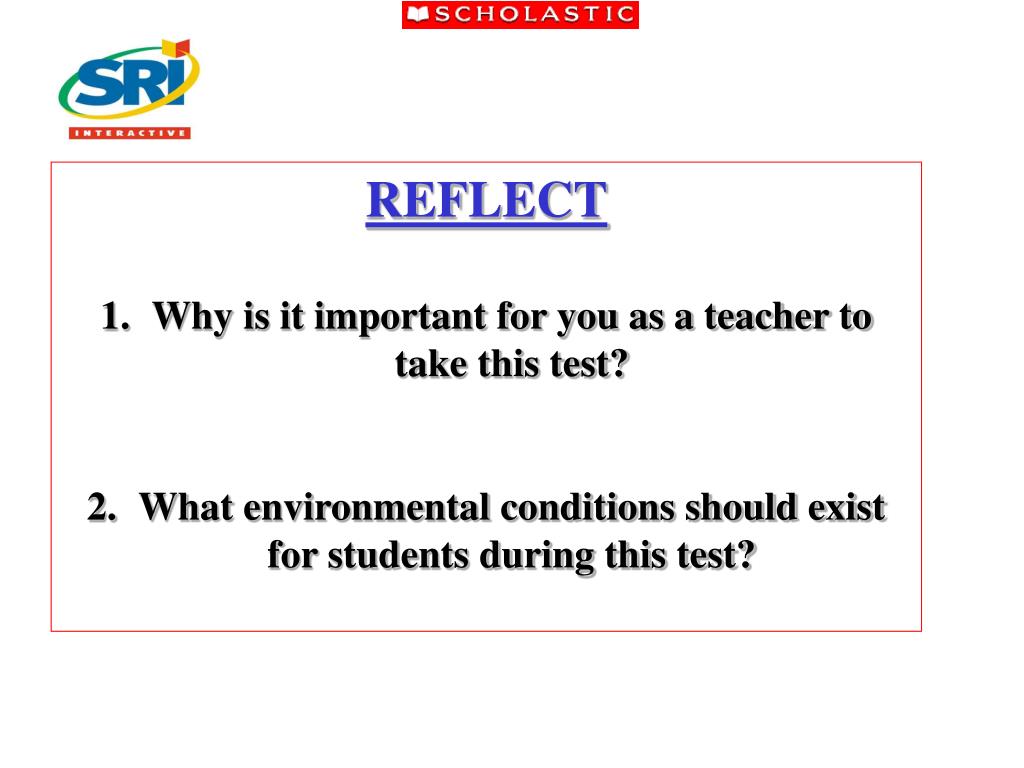

Based on MetaMetrics studies, does the LitPro standard benchmark change yearly?.This time, the order's info does not appear in the active orders. I deleted an order and created a new order.Still others, such as the Developmental Reading Assessment (Beaver, 1997) and the Qualitative. Others, such as informal reading inventories (IRIs) and running records (Clay, 1993) are more informal in nature and are based on teachers’ ability to interpret the reading behaviors that they record. The teacher can see data for both quizzes, however the student can only see the second quiz result. administered Woodcock Reading Mastery Test. Then they took the quiz again and passed.

Student took an eBook quiz and failed.Teachers can use their students' scholastic reading. The SRI test is a computer-adaptive test based on the Lexile Framework, a reading measure that matches students to text, taken in a low-pressure setting with no time constraints. Only some students are listed on the report. Teachers use the Scholastic Reading Inventory (SRI) test to assess students' levels of reading comprehension.
SCHOLASTIC READING INVENTORY TEST FULL
The Class Lexile History Report is not showing the full list of students in the class.Teacher added points are not showing up in the class reading report card.It said BR until the last test when it was slightly above 100L. A school did not believe that a child's Lexile score was accurate when it came back as BR, so they tested him three more times that week.Why is this happening and how can it be fixed? Sometimes when students search for book quizzes that we know are in LitPro they don't come up, but when the teacher searches for them they're visible.What was in those boxes? And why did Stretch have one blue hand? She was _. Questions that nagged away at the back of her mind. In spite of the way Kate talked to Anders, she had some questions of her own. She was a “fashion designer.” She was _.Ģ. She wouldn’t call herself a “seamstress.” Even “dressmaker” wasn’t fancy enough for Hattie. Ask for evidence to back up answers to comprehensive questions.ġ. Help by asking WHY questions and by making predictions on what will happen next.

This is a skill that needs to be developed. INFERENCE, INFERENCE, INFERENCE: Inferences are “reading between the lines.” You child must search for clues, use their own knowledge, and then formulate an inference. When the reading session ends, the parent/guardian can retell important details that were missed.ĥ. During the 3rd read, ask revealing questions like “When? Where? Why? What? With Who? & How?” to bring focus on the main points of the story. Discuss the details that were added when the read the 2nd time through. Then after your child rereads, have them retell again. COMPREHENSION: After your child reads the passages on the first read, have them retell the details they can recall. Remember, practice makes permanent! 20 minutes is the required reading time for 2nd graders however, I strongly suggest 40 minutes of reading nightly for struggling readers to include weekends.Ĥ. PRACTICE, PRACTICE, PRACTICE: For a child to elevate their reading level (especially if they are behind), MORE practice reading with adult supervision is needed. Re-reading text is the BEST way to build fluency in order to achieve comprehension.ģ. Once the correct fluency (speed at which your child reads smoothly- which is directly linked to comprehension) is accomplished throughout a paragraph, reread the paragraph until it can be read by the child as quickly as an adult. The SRI is a universal screener and standardized assessment. REPEAT, REPEAT, REPEAT- RE-READ TEXT!!!!: As your child reads a book within their Lexile range (see SRI test report), a sentence should be read over and over until they can read it as fast as an adult. Pinnell Running Record and the Scholastic Reading Inventory. Words 1-600 are expected to be mastered before the end of second grade.Ģ. It is imperative that the Fry words are memorized and read fluently. By the end of first grade, to be on grade level, students should have mastered the first 300 words. Good readers decode "instantly" ensuring the automaticity essential to reading comprehension. FRY WORDS: Fry words make up almost half of the words met in any reading task. Here are a few suggestions to help your child at home (especially if your child’s score is below 300):ġ. This year, your child must earn a minimum of 330L on any SRI test taken before the end of the year to be promoted to third grade (below 2nd grade’s SRI “beginning” Lexile). In order for a student to be promoted to third grade, students must score a minimum of 330 on the SRI test. Scholastic Reading Inventory (SRI) is an objective assessment of a student’s reading comprehension level. Therefore, according to the SRI test, a 2nd grader at the beginning of the year should start with a score around 350. The proficient Lexile range for 2nd grade is 410-1700+. Our class will take the SRI (Scholastic Reading Inventory) benchmark test three separate times throughout the school year.


 0 kommentar(er)
0 kommentar(er)
